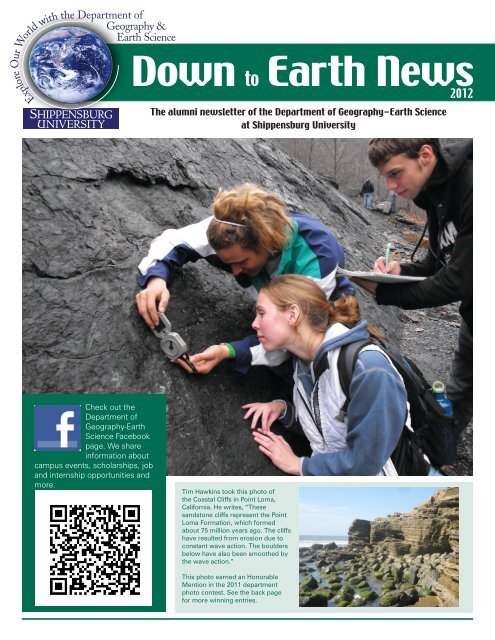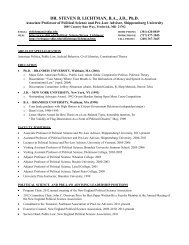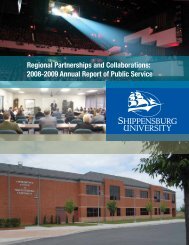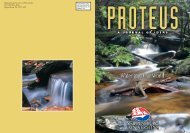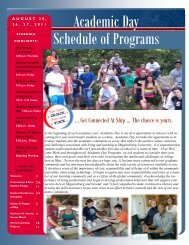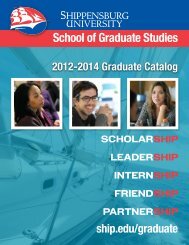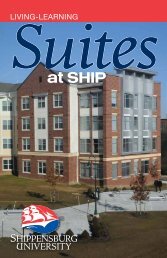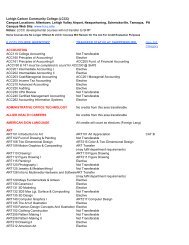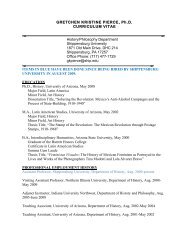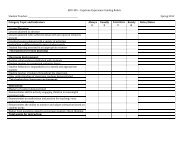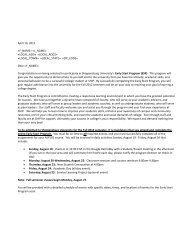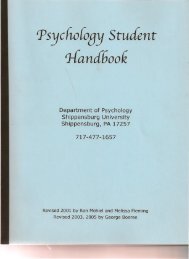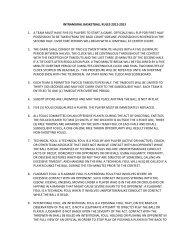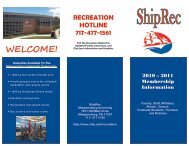pdf version - Shippensburg University
pdf version - Shippensburg University
pdf version - Shippensburg University
Create successful ePaper yourself
Turn your PDF publications into a flip-book with our unique Google optimized e-Paper software.
2012<br />
The alumni newsletter of the Department of Geography-Earth Science<br />
at <strong>Shippensburg</strong> <strong>University</strong><br />
Check out the<br />
Department of<br />
Geography-Earth<br />
Science Facebook<br />
page. We share<br />
information about<br />
campus events, scholarships, job<br />
and internship opportunities and<br />
more.<br />
Tim Hawkins took this photo of<br />
the Coastal Cliffs in Point Loma,<br />
California. He writes, “These<br />
sandstone cliffs represent the Point<br />
Loma Formation, which formed<br />
about 75 million years ago. The cliffs<br />
have resulted from erosion due to<br />
constant wave action. The boulders<br />
below have also been smoothed by<br />
the wave action.”<br />
This photo earned an Honorable<br />
Mention in the 2011 department<br />
photo contest. See the back page<br />
for more winning entries.
News from Department Chair Dr. William Blewett<br />
Greetings everyone! The past two years<br />
have been especially challenging for Pennsylvania’s<br />
state universities, and <strong>Shippensburg</strong><br />
<strong>University</strong> is no exception. After threatening to<br />
cut the university’s state appropriation by more<br />
than 50% (which would have effectively closed<br />
down the university), the governor eventually<br />
agreed to a cut of “only” 19%, still an enormous<br />
economic hit, and one made more egregious by<br />
the years of belt tightening that preceded it. As<br />
I write this column, the governor has proposed<br />
a 20% cut for the State System for 2012-2013.<br />
How long our university system can continue<br />
to absorb such drastic cuts is anybody’s guess.<br />
Thankfully, <strong>Shippensburg</strong> has been able to<br />
weather the storm more easily than some of<br />
our sister schools (at least so far), but only<br />
by drastically reducing academic support and<br />
significantly increasing the number of students<br />
in our courses.<br />
Despite these challenges, the Geography-<br />
Earth Science Department has never been<br />
stronger, with more than 200 undergraduate<br />
majors and 30 graduate students. Our GIS<br />
major has increased from a handful of students<br />
just a few years ago, to more than 30 students<br />
this spring. At the same time, the department<br />
has earned more than $250,000 in competitive<br />
grants from a diverse set of funding organizations.<br />
One of the largest was a $197,000 grant<br />
from the National Science Foundation to<br />
integrate Ground Penetrating Radar (GPR)<br />
and related technologies across our curriculum.<br />
Drs. Zume and Cornell spearheaded this effort,<br />
aided by Drs. Woltemade and T. Feeney.<br />
The department purchased nearly $118,000<br />
of geotechnical equipment with this grant and<br />
is expanding our field techniques curriculum<br />
with a new course, Field Techniques II, taught<br />
by Dr. Zume, and focused on using GPR,<br />
Electrical Resistivity, and related techniques<br />
to solve environmental problems. The course<br />
will be taught this summer for the first time.<br />
Meanwhile, our faculty members continue<br />
to publish their research in a wide array of<br />
national journals including The Professional<br />
Geographer, Journal of the American Water Resources<br />
Association, Bulletin of the Ecological<br />
Society of America, Journal of Paleolimnology, and<br />
the Pennsylvania Archaeologist. Dr. Jan Smith<br />
continues to run the Pennsylvania Geographic<br />
Alliance (the organization responsible for promoting<br />
K-12 geography in Pennsylvania) from<br />
her office in Rowland Hall, and was recently<br />
recognized as a “Pennsylvania Distinguished<br />
Geographer” by the Pennsylvania Geographical<br />
Society. Dr. Paul Marr was recently elected<br />
president of the Middle States Division of the<br />
Association of American Geographers, an<br />
office of national prominence. He also edits<br />
the division’s journal, The Middle States Geographer.<br />
In addition, through the efforts of Dr.<br />
Claire Jantz, <strong>Shippensburg</strong> <strong>University</strong> gained<br />
membership in the Chesapeake Cooperative<br />
Studies Unit, which will allow SU faculty to<br />
compete for research and funding opportunities<br />
with multiple federal agencies. I’ve only<br />
scratched the surface of our activities over<br />
the past two years, and I urge you to review<br />
the faculty reports elsewhere in the newsletter.<br />
Collectively, these activities rival research<br />
institutions like Penn State or the <strong>University</strong><br />
of Maryland, and are all the more remarkable<br />
given our significant teaching loads.<br />
Dr. Pomeroy has returned to the department<br />
after serving two years as the Interim<br />
Director of the Institute for Public Service and<br />
Sponsored Programs, the grants administration<br />
arm of the university. Both the students<br />
and his colleagues are glad to have him back<br />
safe and sound in Shearer Hall.<br />
Our students continue to be involved in<br />
research with faculty and engaged in field study.<br />
Dr. Cornell took a group of students to Curaçao<br />
in the Caribbean again last year and each<br />
participant was required to produce a poster<br />
related to a particular research topic. Dr. Alison<br />
Feeney ran a similar trip to Bermuda concerned<br />
with mapping and GIS. Dr. Pomeroy will be<br />
leading students on a field trip to China this<br />
summer. This will be his fourth trip to China<br />
over the past eight years.<br />
Most of all, we are appreciative of the<br />
support our alumni provide to the Geography-<br />
Earth Science Department, through service on<br />
our Advisory Board, by hiring our students (for<br />
internships and full-time positions), and by<br />
making donations to the department through<br />
the SU Foundation. Dr. Bob Harper (who<br />
retired from the department several years ago)<br />
and his wife Betty have recently established a<br />
new scholarship to honor deserving undergraduate<br />
students. Thanks Bob and Betty for<br />
your interest and dedication to the department<br />
over the years! For those who have already established<br />
scholarships, the department extends<br />
our continued appreciation and gratitude, especially<br />
in these stressful economic times. For<br />
those interested in establishing a scholarship<br />
or contributing to the department directly, I<br />
urge you to contact Beth McKinley at the SU<br />
Foundation, or you may contact me directly.<br />
In closing, may I please ask you to take just<br />
a few minutes to complete the attached survey<br />
and return it to us You can also access it online<br />
and submit it to the website noted on the form.<br />
It’s one of the only ways that we can get a good<br />
idea of how we’re doing and what needs to be<br />
changed. If there’s something you liked about<br />
our program and want to see it maintained,<br />
let us know. Conversely, if we need to change<br />
something, we’ll never know unless you tell<br />
us. The next few years will be especially challenging<br />
to the department as State support of<br />
Higher Education continues to dwindle. You<br />
can help us by providing valuable feedback<br />
for the important decisions yet to come. Also,<br />
don’t forget to visit our Facebook page, which<br />
includes departmental news as well as employment<br />
opportunities in the environmental<br />
sciences. Thank you and best wishes!<br />
Ship to Host Middle States<br />
Geography Conference<br />
The Middle States Division of the<br />
Association of American Geographers<br />
will be holding its annual meeting at<br />
<strong>Shippensburg</strong> <strong>University</strong> in November<br />
2012. We are in the process of organizing<br />
the conference, which is tentatively set for<br />
November 2 and 3, 2012 in the Ceddia<br />
Union Building.<br />
We hope to have four concurrent<br />
paper sessions and a poster session over<br />
the two day conference. We are planning<br />
on having approximately 16 individual<br />
sessions, so if you would like to organize<br />
a paper session please contact Dr. Paul<br />
Marr at pgmarr@ship.edu. The official<br />
Call for Papers will be either at the end<br />
of April or early May, before the summer<br />
break. If you are currently not a member<br />
of Middle States, please consider joining.<br />
2 Down to Earth News 2012
Department Faculty Updates<br />
Mike Applegarth<br />
I have continued<br />
my work in the southwestern<br />
U.S. using<br />
remotely sensed imagery<br />
to assess landscape<br />
evolution and changes.<br />
Most recently, I presented<br />
results at the<br />
AAG meeting from<br />
my ongoing research<br />
assessing land use changes in Mohave County,<br />
Arizona. In the geography department, I have<br />
become chair of the Facilities and Resource<br />
Management Committee which oversees the<br />
department budget — with much help from<br />
Judy Ferrell — and maintains the building<br />
facilities. The geography department at the<br />
<strong>University</strong> of Northern Iowa, where I received<br />
my master’s degree, recently awarded me with<br />
Alumnus of the Year. I am very proud of this<br />
honor and will travel to receive the award in<br />
April.<br />
William Blewett<br />
I continue to serve<br />
as chair of the Geography-Earth<br />
Science<br />
Department, a responsibility<br />
that requires<br />
a great deal of time<br />
and effort. I also continue<br />
to teach Physical<br />
Geology, Geology of<br />
National Parks, and<br />
graduate Geomorphology. Field work is a big<br />
part of these courses and I still take students to<br />
South Mountain each semester and to Maryland<br />
and Great Falls in the spring.<br />
I’ve spent the last four years writing a book<br />
entitled Geology and Landscape of Michigan’s<br />
Pictured Rocks National Lakeshore and Vicinity<br />
for the National Park Service. The book is<br />
finally finished and will be released on March<br />
15 (available for $22.95 on Amazon.com’s<br />
website — preorder now!), and I’m looking<br />
forward to a return to normal life. This past<br />
fall Dr. Drzyzga and I spent three weeks<br />
of our sabbatical in the Upper Peninsula of<br />
Michigan measuring elevations of ancient<br />
glacial lake shorelines and their relationship to<br />
nearby moraines. We will be returning to the<br />
Upper Peninsula to finish our work this summer,<br />
with an article (we hope) to follow. I am<br />
also working with Walt Loope from the U.S.<br />
Geological Survey on a manuscript describing<br />
the spillover of glacial Lake Minong across<br />
the eastern Upper Peninsula during the early<br />
Holocene. Closer to home, I continue to work<br />
with SU students on topics relating to soils and<br />
relict periglacial landforms. Along with Dr.<br />
John Wah (an adjunct in our department), I’m<br />
readying a manuscript with students Corinne<br />
Koiro and Gus Frederick on the relationship<br />
of certain periglacial landforms to nearby soil<br />
development. The research will be presented<br />
at the Association of American Geographers<br />
meeting in New York City this February.<br />
Since relinquishing my chairmanship of<br />
the <strong>University</strong> Forum (faculty senate) several<br />
years ago, I’ve focused on departmental matters<br />
and building our enrollments. I continue<br />
to serve on the College Council of the College<br />
of Arts and Sciences and was on that organization’s<br />
Executive Committee for several years.<br />
I also serve on a number of university and<br />
departmental committees.<br />
During the three to four hours per week<br />
that I’m not at work, I reside with my wife,<br />
Gretchen, at the base of South Mountain<br />
outside <strong>Shippensburg</strong>, on a stabilized colluvial<br />
apron of Pliocene/Pleistocene age.<br />
Sean Cornell<br />
Since the last newsletter, life in the department<br />
has been very busy. I am blessed<br />
to have an excellent group of colleagues and<br />
students to work with. Despite the challenges<br />
our department and university have faced with<br />
ever reducing budgets, I am proud of the many<br />
worthwhile accomplishments we have made. I<br />
have been working to expand opportunities for<br />
Geo-ESS students to participate in field learning<br />
experiences. Each spring, more than 30 students<br />
are involved in teaching environmental<br />
education programs to K-5 grade students. I<br />
also continue to teach summer courses at the<br />
Marine Science Consortium in Wallops Island,<br />
Virginia. Each year we have more students<br />
taking advantage of classes there. Last January,<br />
we took 12 students to Curaçao (formerly the<br />
capital island of the Netherlands Antilles). This<br />
was our second trip, and we had an opportunity<br />
to meet with the Consul General Valerie Belon<br />
to learn about the many political changes going<br />
on in Curaçao as a result of recent public<br />
referendums. It was an excellent opportunity<br />
for our students. Also together with Dr. Jantz<br />
and Dr. Drzyzga and other colleagues across<br />
campus, we raised over $20,000 to take 53<br />
students from a range of majors to the Gulf<br />
Coast in the fall of 2010. The purpose of our<br />
trip was to learn first-hand about the impact of<br />
the Deep Water Horizon Oil Spill, and to see<br />
how the region was recovering from Hurricane<br />
Katrina, five years later. We engaged students<br />
in service-learning projects that put them in<br />
contact with local residents, scientists, and oil<br />
spill clean-up workers. It was among the most<br />
impactful learning experiences I have ever had<br />
the privilege of being a part of.<br />
Outside of the classroom, Dr. Zume,<br />
Dr. Feeney, Dr. Woltemade and I continue to<br />
make progress on our NSF-funded grant to<br />
develop curricular enhancements that integrate<br />
Geophysical field methods into the classroom.<br />
Students now regularly use the GPR (Ground<br />
Penetrating Radar) equipment in both Physical<br />
Geology and upper-level courses and most<br />
students report very favorable experiences and<br />
interest in such geotechnologies. Through my<br />
association with the Marine Science Consortium,<br />
I am also now engaged in a project<br />
to help NASA with shoreline monitoring<br />
at its Wallops Island Flight Facility. With a<br />
colleague from Kutztown <strong>University</strong>, I have<br />
engaged in a year-round beach surveying<br />
program to monitor ground water, beach morphology,<br />
sediment analysis, and beach migration<br />
rates. Hurricane Irene proved to be quite<br />
significant for the shoreline, and has led NASA<br />
and the U.S. Fish and Wildlife Service to reinvestigate<br />
their long-term plans. Currently<br />
NASA is pursuing a beach replenishment<br />
initiative to protect the multi-billion dollar<br />
launch facility which will serve both orbital<br />
and sub-orbital rocket launches through the<br />
next decade or more.<br />
Personally, I together with my family, had<br />
an opportunity to explore the eastern Caribbean<br />
during this past winter break. With all my<br />
time in the northern and southern Caribbean,<br />
this was my first opportunity to explore the<br />
subducting end of the Caribbean Plate firsthand.<br />
I didn’t have enough time to explore so<br />
I can’t wait to go back. Anyone want to come<br />
along Best wishes to all!<br />
Scott Drzyzga<br />
Hello Gang. I’m happy to report many<br />
good things. First, I earned a sabbatical leave<br />
(Fall 2011) and accomplished everything I set<br />
out to do. I continued my work to unravel the<br />
(continued on page 4)<br />
Down to Earth News 2012 3
Department Faculty Updates<br />
(continued from page 3)<br />
mysteries of Glacial Lake Algonquin, which<br />
existed in the Great Lakes basin approximately<br />
12,000 years ago. Dr. Blewett and I conducted<br />
weeks of fieldwork in Michigan’s Upper Peninsula<br />
regarding some newly discovered ancient<br />
shorelines, and we developed new hypotheses<br />
about moraine development in the region.<br />
We’re going back to the “UP” during Summer<br />
2012 to virtually excavate a massive pro-glacial<br />
delta with some new Ground Penetrating<br />
Radar technology. Also, my latest manuscript<br />
about the ancient lake is in press and will be<br />
published in a forthcoming issue of the Journal<br />
of Paleolimnology.<br />
Dr. Claire Jantz<br />
and I are still working<br />
together. We’re beginning<br />
to wrap up our<br />
five-year effort (National<br />
Science Foundation)<br />
to build new<br />
knowledge about the<br />
Baltimore metropolitan<br />
area, and to better<br />
understand how urban growth is changing<br />
the region’s water supplies. We took graduate<br />
student Michael Maret and undergraduate students<br />
Ben Ritter and Gus Frederick to Seattle,<br />
WA, to present new findings at the Association<br />
of American Geographer 2011 Annual Meeting;<br />
each did a great job. To follow up, Claire<br />
and I just submitted a new research proposal<br />
that seeks to answer fundamental questions<br />
regarding future urban growth, land cover<br />
change and water quality conditions across the<br />
entire Chesapeake Bay Watershed.<br />
In October 2011, students Scott Evans<br />
and Deb Whitmoyer, and I, attended the 6th<br />
Annual NW Pennsylvania GIS Conference.<br />
The conference was filled with presentations<br />
and talk about the Marcellus Shale gas play<br />
and the related demand boom for GIS-related<br />
products and services. Scott and Deb both presented<br />
work they accomplished in our Applied<br />
GIS course. I should note that we ran Applied<br />
GIS a little differently than usual last year, for<br />
we visited with the National Park Service’s map<br />
production staff in Harper’s Ferry and learned<br />
how to achieve high-quality map designs using<br />
ArcGIS, Adobe Illustrator, and the National<br />
Park Service’s map/brochure style sheets. Our<br />
students made some stunning map products<br />
in that class.<br />
In January 2012, I became a Certified<br />
Geographic Information Systems Professional<br />
(GISP). Former students of GIS III<br />
(aka Advanced GIS) should recall beginning<br />
their application processes in college so that<br />
adding to and amending their applications will<br />
be easy as each develops the required years of<br />
professional on-the-job experience. I’m pleased<br />
to share that alumna Katie Howard (nee Hess)<br />
also became a Certified GISP in January.<br />
For those keeping track, our GIS and Ford<br />
Labs are running ESRI ArcGIS for Desktop<br />
10 (ArcInfo), ESRI Business Analyst, the latest<br />
<strong>version</strong> of ERDAS Imagine, Surfer 10, and<br />
Trimble GPS Pathfinder Office 5.2, among<br />
many others. Also, we upgraded our fleet of<br />
Trimble GPS/GNSS hardware. We now have<br />
two survey-grade GeoExplorer 6000s and a<br />
dozen mapping-grade GeoXM units to support<br />
classroom instruction, student research,<br />
and our summer Field Techniques course.<br />
Last but not least, I’d love to hear from<br />
you. Anything you can share with us about your<br />
experiences at Ship or in the current GIS job<br />
market will help us to better help our students.<br />
sadrzy@ship.edu.<br />
Allison Feeney<br />
Hi everyone.<br />
As in the past I<br />
continue to teach<br />
GIS and cartography<br />
courses,<br />
continually updating<br />
skills with<br />
the changing demands<br />
of technology<br />
and the<br />
limitless possibilities geography has to offer.<br />
The past two years I have been working with<br />
students interested in the Atlantic trade, with<br />
particular focus on Bermuda. My own research<br />
has been examining historic maps created in<br />
the first 100 years of settlement of the New<br />
World, and analyzing the accuracy of these<br />
early maps in a GIS. Last summer I went with<br />
a graduate student, Stewart Beattie to Bermuda,<br />
who was using GIS to map shipwreck<br />
data, and this fall break I took ten students<br />
from an honor’s course, “The World of Pirates”<br />
to Bermuda. While there, we stayed in the<br />
historic Naval Dockyards, mapped features for<br />
a 3D tour, visited with an underwater archaeologist,<br />
snorkeled the coral reefs, and saw many<br />
of the islands cultural and physical landscapes.<br />
Closer to home I have been working with<br />
another graduate student who is mapping the<br />
street trees in the borough of <strong>Shippensburg</strong>.<br />
While this initial phase is part of his graduate<br />
research, he intends to establish a GIS for the<br />
borough and the university to collaboratively<br />
map, study, and manage the urban trees. I also<br />
continue to work with student organizations<br />
such as the adventure club and ski club where<br />
I can express my love for outdoor activities<br />
such as whitewater rafting, kayaking, skiing,<br />
and tennis.<br />
Tom Feeney<br />
Well, my office is<br />
no cleaner than the<br />
last time you were here<br />
in Shearer Hall! I have<br />
had no difficulty at all<br />
filling up Dr. Benhart’s<br />
old office with assorted<br />
stuff. I’d like to think it<br />
is all there ready to go<br />
to class or in the field at a moment’s notice,<br />
but you know better.<br />
The classes seem to be boiling along as<br />
maybe you once remember them. I continue<br />
to work away at making Hydrogeology a “realworld”<br />
class, as I’m still waiting for that perfect<br />
37º F day with light rain to run that SLUG<br />
test. And, I’m working to incorporate some<br />
geophysics into the Environmental Geology<br />
class thanks to the combined efforts of Drs.<br />
Cornell, Zume, and Woltemade into bringing<br />
that equipment to the Department. On<br />
the research side, I continue to monitor the<br />
hydrology of springs in the region, with a major<br />
effort being placed on the Cleversburg Sink<br />
Cave system. The system is not far away, and<br />
is adjacent to the mighty Burd Run channel<br />
just a few miles upstream from campus. Some<br />
really neat stuff is coming out of there that<br />
might indicate (that’s a strong statement!) that<br />
some Burd Run water could be flowing to an<br />
entirely different watershed. Wouldn’t that be<br />
something! Unfortunately, we have to wait for<br />
just the right hydrologic conditions to test this<br />
idea. Some students and I are also making trips<br />
into the cave on a regular basis to collect water<br />
samples to evaluate how the speleothems (cave<br />
formations) in there are forming. Stay tuned!<br />
I continue to help Dr. Hawkins collect<br />
weather data at the station to satisfy the<br />
weather-geek side of me, and I have done a<br />
bit of work to help the <strong>Shippensburg</strong> Borough<br />
Water Authority site a new water supply well.<br />
As some of you may recall, we have had great<br />
success in the past siting very productive wells<br />
for the Borough, but going to the trough<br />
too often may be creeping up on my batting<br />
average.<br />
Please drop me a note and let me know<br />
how you are doing.<br />
4 Down to Earth News 2012
Department Faculty Updates<br />
Kurt Fuellhart<br />
I continue to teach<br />
courses in human geography<br />
including<br />
Cultural Geography,<br />
Geography of the<br />
U.S.A. and Canada,<br />
and Economic Geography.<br />
My research<br />
involves the geography of air transport services<br />
and other regional economic issues. I have<br />
recently co-authored conference papers for<br />
several international meetings including the<br />
International Conference of the Hong Kong<br />
Society for Transportation Studies (2010) in<br />
Hong Kong, SAR, China, The Association of<br />
American Geographers Conference (2011) in<br />
Seattle, Wash., and the Air Transport Research<br />
Society Annual Conference (2011) in Sydney,<br />
NSW, Australia.<br />
Tim Hawkins<br />
Hi everyone! I<br />
continue to teach and<br />
research in the fields<br />
of meteorology and<br />
climatology. I am<br />
on sabbatical during<br />
Spring 2012 working<br />
on two projects. The<br />
first builds on some previous work by examining<br />
the role that three-dimensional computer<br />
simulations and three-dimensional tangible<br />
models have in student learning of challenging<br />
meteorological concepts. I’m working with Jan<br />
Smith and we’ve initially found some interesting<br />
differences in student scores depending on<br />
whether students use a 2-D or 3-D model as<br />
well as some interesting sex-based differences.<br />
My other project involves building a hydrologic<br />
model of the Chesapeake Bay Watershed.<br />
With a functioning model, I hope to examine<br />
the impact of projected climate change and<br />
land use change in the coming decades on the<br />
runoff to the Bay as well as the hydroclimate<br />
of the watershed. I will also be able to use the<br />
model in my classes and for future student<br />
research. I still very much enjoy working with<br />
students on research projects. Some recent<br />
student projects include: climate change along<br />
the Appalachian Trail, modeling the impact<br />
of green roofs on buildings, and examining<br />
<strong>Shippensburg</strong>’s urban heat island.<br />
I continue to maintain the weather station<br />
on campus and somehow got roped into being<br />
department chair for the Fall 2011 semester<br />
while Dr. Blewett was on sabbatical. I think I<br />
was the only person still standing in the room<br />
after everyone else ran away when they asked<br />
who wanted to be chair….I hope you are all<br />
doing well and would love to hear an update<br />
from you!<br />
Claire Jantz<br />
I can’t believe I have been at <strong>Shippensburg</strong><br />
<strong>University</strong> for almost seven years. Time flies<br />
when you’re having fun, right I manage to<br />
keep myself occupied on a variety of teaching<br />
and research projects. I am excited about a<br />
new NASA-funded research project that will<br />
focus on mapping and monitoring of wetland<br />
dynamics for improved resilience and delivery<br />
of ecosystem services in the Mid-Atlantic<br />
region. I also have two research proposals in<br />
review to continue on urbanization research in<br />
the Mid-Atlantic region, and to study settlement<br />
patterns and environmental change in<br />
the Andes using remote sensing techniques<br />
and field-based data collection. My fingers<br />
are crossed for a favorable outcome with those<br />
proposals, both of which have been submitted<br />
to the National Science Foundation. The<br />
work I have done to write and, occasionally,<br />
win funded research awards was recognized in<br />
2010, when I was awarded the Provost’s Award<br />
for Extraordinary Service.<br />
I still teach several classes, including<br />
World Geography, Conservation of Natural<br />
Resources, Land Use, Urban Geography, and<br />
a graduate course on the Science of Land Use<br />
Change. A lot of my research feeds directly into<br />
my classes and into research I do with students.<br />
I am so proud of some of the student research<br />
projects I have advised that I recently launched<br />
a new page on my website to publish student<br />
white papers. Please take a look at http://<br />
webspace.ship.edu/cajant/student_white_papers.html<br />
and see some of the great research<br />
students are doing in the field of land use and<br />
land cover change.<br />
I continue to serve as the department’s<br />
internship coordinator, and last academic<br />
year helped to place over 80 undergraduate<br />
and graduate students. It is rewarding to see<br />
our students develop academically and professionally<br />
at their internships, and I invite you to<br />
read about some of our featured internships on<br />
our website (http://www.ship.edu/Geo-ESS/<br />
Internships/). And, please keep us in mind if<br />
your agency or company is seeking interns.<br />
In my free time, my husband and I continue<br />
to keep honeybees as a hobbyist beekeeper<br />
and to participate in NASA’s HoneyBeeNet<br />
as citizen scientists (http://webspace.ship.edu/<br />
cajant/research_honeybeenet.html). We have<br />
also brought a third dog into our household,<br />
a rescue that I brought home from field work,<br />
and the pack keeps us busy with dog school,<br />
hiking, and tennis ball.<br />
Paul Marr<br />
This semester<br />
I have been reacquainting<br />
myself<br />
with the department,<br />
having just<br />
returned from a<br />
one-year sabbatical.<br />
Spent some<br />
of my time taking<br />
a much needed<br />
break, with the rest being devoted to proposal<br />
writing, pushing some back-burner research<br />
projects up to the front burner (where they<br />
were immediately overcooked), and preparing<br />
manuscripts. Former state archaeologist<br />
Stephen Warfel and I were able to get another<br />
PHMC grant for excavations at the Fort Morris<br />
site. The dig will begin in May 2012, with<br />
our goal being to locate the fort’s palisade wall<br />
and ultimately determine the layout of the fort,<br />
its size, and its position on the landscape. I was<br />
also able to get a few manuscripts out the door:<br />
one written with Dr. Jantz entitled “Aymaran<br />
Village Abandonment on the Chilean Dry<br />
Puna”, which we sent to Mountain Research<br />
and Development Journal, and the other (and<br />
my personal favorite) was “Geography of the<br />
British Motorcycle Industry: 1896-2004”,<br />
which was sent to Transport History Journal.<br />
The Aymaran village abandonment paper resulted<br />
in the development of research proposals<br />
to NOAA (not funded) and NSF (which will<br />
be submitted in January, 2012). Dr. Jantz and I<br />
hope to be working with a Chilean agronomist,<br />
an Aymaran linguist, and the Woods Hole<br />
Research Center to investigate the mechanisms<br />
that have led to depopulation on the dry puna<br />
of northern Chile. Dr. Jantz and I are also in<br />
the process of developing a field study course in<br />
northern Chile that would take students from<br />
the coastal mountain range and the abandoned<br />
nitrate mines, through the Atacama desert,<br />
and up into the Andes Mountains. I think this<br />
would be an amazing opportunity for students<br />
(continued on page 6)<br />
Down to Earth News 2012 5
Department Faculty Updates<br />
(continued from page 5)<br />
and hope we are able to make this field experience<br />
a reality.<br />
If the vote goes my way (and it should because<br />
I paid enough for it!) I hope to be elected<br />
as President of the Middle States Division of<br />
the AAG. This year’s MSD conference will<br />
be held here at <strong>Shippensburg</strong> <strong>University</strong> in<br />
November. This is a great opportunity for us<br />
to showcase our department and university to<br />
fellow geographers, and I am looking forward<br />
to making the 2012 MSDAAG conference<br />
a success. I was recently asked to become the<br />
editor of the Pioneer America Society’s online<br />
journal Pioneer America Society Transactions<br />
(PAST). This is a great organization and if you<br />
have an interest in North American history I<br />
would urge you to attend a meeting (Philadelphia<br />
in 2012). Along the same vein, I was<br />
also asked to be the editor of Middle States<br />
Division’s journal, the Middle States Geographer.<br />
Both should keep me busy, and by the end of<br />
all of this I will probably be ready for another<br />
sabbatical.<br />
For those who are keeping track, this year’s<br />
trout count was dismally low… I blame it on<br />
the rain and then the lack of rain…<br />
George Pomeroy<br />
After two<br />
challenging and<br />
enjoyable years<br />
serving as the SU’s<br />
Interim Director<br />
of the Institute for<br />
Public Service and<br />
Sponsored Programs,<br />
I am very<br />
glad to rejoin my colleagues and our students<br />
full-time in the department. While the administrative<br />
job was a wonderful learning experience,<br />
I can say that “hands down,” nothing<br />
beats being in the classroom engaging in ideas<br />
with students.<br />
Planning — local, city, town, environmental,<br />
and land use — continues to be a theme of<br />
my teaching and research. As Director of the<br />
Center for Land Use, I have played a role in cooperative<br />
efforts to plan along the I-81 Corridor<br />
and in the South Mountain Partnership, a large<br />
landscape conservation planning effort centered<br />
on the South Mountain region. Several student<br />
research and service projects, mostly through the<br />
Land Use, Environmental Land Use Planning<br />
(ELUP), and Geography Seminar courses, have<br />
spoken to these initiatives.<br />
As with the last newsletter, I can report<br />
another successful field course in China. In<br />
the summer of 2010, we (the students, our<br />
children Megan and Eileen, and, of course,<br />
Jennifer and I) again visited Shanghai, Beijing,<br />
and Hangzhou. Again, I can safely say that the<br />
country is changing rapidly; modernizing at<br />
breakneck speed. A unique twist to the 2010<br />
trip was our visit to Expo 2010 — the world’s<br />
fair. The fair’s theme — Better City, Better Life<br />
— featured city planning and was intended as<br />
a signal of Shanghai’s emergence as a global<br />
city. The day we visited so did 380,000 other<br />
people! We also made our first visit to Beijing’s<br />
Urban Planning Exposition Hall. Similar to<br />
the Shanghai’s urban planning museum, the<br />
exhibit features an impressive scale model of<br />
the city. A cultural first was our visit to Chairman<br />
Mao’s Mausoleum, where we respectively<br />
witnessed the remains of the Great Helmsman<br />
inside a crystal coffin for public viewing.<br />
As always, I am very glad to hear from<br />
alumni. Hearing from you allows us to inspire<br />
students, as they need role models (you), great<br />
case studies (your projects), and encouragement<br />
in their personal and career development.<br />
Jan Smith<br />
Greetings from<br />
<strong>Shippensburg</strong>! It is<br />
hard to believe that<br />
I am beginning my<br />
10th year at <strong>Shippensburg</strong><br />
this year<br />
— where has the<br />
time gone I have<br />
no trouble remembering the two years we spent<br />
in Gilbert Hall or the small and warm GIS lab<br />
in the basement of Horton Hall. Who could<br />
forget those, right But, it is hard to believe<br />
that we have been back in the renovated Shearer<br />
Hall for over five years. The GIS lab and<br />
the Ford lab are getting an incredible workout<br />
these days with more majors in our department<br />
as well as more students from across campus<br />
interested in learning GIS.<br />
Besides teaching GIS and Cartography,<br />
I continue to teach World Geography, the<br />
Geography of Europe, and, since 2011, have<br />
been teaching our Senior Capstone Seminar<br />
in the spring semester. As always, I am fortunate<br />
to get to work with the students from our<br />
department who are pursuing their degrees in<br />
Earth-Space Science and Geography-Social<br />
Studies education!<br />
I am involved in several other projects<br />
beyond the <strong>Shippensburg</strong> <strong>University</strong> classroom<br />
which keep my calendar relatively full. I<br />
serve as the Coordinator for the Pennsylvania<br />
Alliance for Geographic Education — a nonprofit<br />
organization which focuses on teaching<br />
and learning of geography at all levels and is<br />
funded, in part, by the National Geographic<br />
Education Foundation. We provide professional<br />
development opportunities for teachers<br />
across the state as well as other types of support<br />
for their teaching of geography. Over the<br />
past several years, I have been working with<br />
several colleagues from across the US developing<br />
a middle school geography textbook<br />
in conjunction with National Geographic<br />
Learning. The other major external project in<br />
my life recently has been my participation on<br />
an NSF funded grant entitled the “Road Map<br />
Project.” Essentially, this panel is working to<br />
develop an educational framework to enhance<br />
the teaching and learning of geography in our<br />
K-12 schools.<br />
I am sure I speak for everyone in the<br />
department—we love hearing from you and<br />
finding out what you have been doing since<br />
leaving Ship. Please keep in touch and come<br />
back and visit!<br />
Kay Williams<br />
I continue teaching the courses I have in<br />
the past and am rotating fall semesters between<br />
teaching Biogeography and Problems of the<br />
Atmospheric Environment graduate class, as<br />
well as Conservation of Natural Resources and<br />
Physical Geography. I had not taught biogeography<br />
for three years so it gave me a chance<br />
to redesign the course which now includes a<br />
PowerPoint presentation, outside activities and<br />
a research paper. If we can get the transportation<br />
situation better, I would also take them to<br />
Waggoner’s Gap in the Kittatinny Ridge for a<br />
field trip as I have in the past.<br />
My responsibilities<br />
as Treasurer<br />
for the Pennsylvania<br />
Geographical Society<br />
(PGS) have<br />
decreased somewhat<br />
since we are finally<br />
moving into the 21 st<br />
Century and are accepting<br />
membership<br />
and conference payments online, including<br />
with PayPal. The website, www.thepgs.org, has<br />
been updated and improved. If you are not a<br />
member of the society, I encourage you to join<br />
which can be done online. Our annual meeting<br />
this year will be held on November 2 & 3,<br />
2012 in Salisbury, MD, the home school of our<br />
Executive Director, Brent Zaprowski. This will<br />
be our second visit to the Eastern Shore and<br />
I’m sure it will be as successful as in the past.<br />
It will be a joint meeting with MADAAG.<br />
6 Down to Earth News 2012
Department Faculty Updates<br />
On a more personal note, my daughter<br />
Lydia decided to continue her education and is<br />
currently enrolled in the master’s program Psychological<br />
Sciences, a new degree. She acquired<br />
an undergraduate degree in psychology here<br />
at Ship in 2003 and took many science classes<br />
between then and now. She is hoping to teach.<br />
She and I had a nice visit to the <strong>University</strong> of<br />
Georgia the first weekend in January to attend<br />
the retirement party of my mentors, advisors<br />
and friends, Al and Kathy Parker. We were just<br />
there a weekend, but it was great to see them<br />
and was nice going back after 17 years!<br />
My grandsons are now 7 (Alex, second<br />
grade) and almost 3 (Zack). With Lydia back<br />
in school and taking night classes, Fred and I<br />
pick up the boys until their dad gets off work<br />
the two nights she has class. It is really fun<br />
watching them grow up.<br />
Christopher Woltemade<br />
I have recently completed some research<br />
with Kurt Fuellhart addressing the potential<br />
for residential water conservation programs in<br />
the <strong>Shippensburg</strong> area. The study examines the<br />
economic costs and benefits of various conservation<br />
programs. We presented papers on the<br />
research at both the AAG and the American<br />
Water Resources Association conferences and<br />
a paper is scheduled to be published this year<br />
in The Professional Geographer.<br />
I’m also working together with Nate Bennett<br />
(MS, Geoenvironmental Studies) on a<br />
stream restoration project on Larry’s Creek in<br />
Lycoming County, PA. A highly-eroded reach<br />
of the creek will be reconstructed in 2012. The<br />
broader project includes monitoring of baseline<br />
conditions and post-project geomorphic<br />
monitoring. I’m really hoping to involve some<br />
students in related projects in the watershed —<br />
there are lots of possibilities!<br />
Personally, I’m keeping very fit by cycling<br />
with the SU Cycling Club. Since every year I<br />
get a year older and the students are always<br />
young and fit, let’s just say I get my money’s<br />
worth at our weekly training ride. After dipping<br />
my toe back into the road racing scene<br />
last fall, I’m hoping to participate in a few<br />
more road races this year. At least they have<br />
master’s categories where I don’t have to race<br />
against 20-year-olds!<br />
Joseph Zume<br />
It’s been a remarkable<br />
journey<br />
here at <strong>Shippensburg</strong><br />
<strong>University</strong>. I am<br />
now in my fifth year<br />
here and still enjoying<br />
every moment<br />
of it. The Department<br />
of Geography and Earth Science is the<br />
BEST!! The atmosphere around here is the<br />
most conducive for productivity; I have very<br />
exciting and dependable colleagues, and a 20-<br />
year department chair that is totally awesome!<br />
Once again, I am thankful to be a part of this<br />
great department.<br />
My teaching has remained on schedule.<br />
I have continued to teach Hydrology, Atmosphere,<br />
World Geography, and the Regional<br />
Geography of Sub-Saharan Africa.<br />
This summer (2012), I will have the privilege<br />
of teaching a field techniques course focused<br />
on Geophysics, a very exciting opportunity.<br />
A graduate-level course on groundwater flow<br />
and contaminant transport is still on my<br />
radar in the near future. Also on track is the<br />
implementation of geophysics into our geoenvironmental<br />
studies curriculum, a product of<br />
an NSF grant that I spearheaded two years<br />
ago. I have also been making significant strides<br />
in the area of scholarship. Over the past two<br />
years, I have published two articles in top-flight<br />
international journals, a journal editorial, and<br />
two other manuscripts are nearing submission.<br />
Similarly, I have continued to present<br />
my research at, at least, two national and/or<br />
regional conferences a year. I’m also gradually<br />
increasing the involvement of undergraduate<br />
and graduate students in my research effort.<br />
Service has continued to be another area<br />
of priority to me. On campus, I still serve as<br />
co-chair of the APSCUF/SU Student Affairs<br />
Committee in addition to serving on<br />
many other committees. To the discipline, I<br />
currently serve as Outreach Director for the<br />
Pennsylvania Geographical Society (PGS)<br />
and Finance Director for the Africa Specialty<br />
Group of the Association of American Geographers<br />
(AAG). This is in addition to serving<br />
as a peer reviewer to several academic journals<br />
and a grant reviewer for the National Science<br />
Foundation (NSF). I also remain in the active<br />
membership of the Association of American<br />
Geographers (AAG), National Groundwater<br />
Association (NGWA), American Geophysical<br />
Union (AGU), and the Pennsylvania Geographical<br />
Society (PGS), and the American<br />
Water Resources Association (AWRA).<br />
Needless to say, my multi-tasking and<br />
time management skills are awesome! Despite<br />
the heavy demand on my time, I still find time<br />
to spend with my beloved daughters, Ngodoo<br />
and Nguveren. We spend lots of time cooking,<br />
going to the gym, riding bikes, row boating,<br />
etc. Those girls make life much more enjoyable<br />
for me and I thank God for blessing me<br />
with them!!<br />
Emeritus Faculty Update From Ron McCall<br />
Mr. Ron McCall and his wife Dorothy have been<br />
keeping busy and are in great spirits these days. For the<br />
last couple of years, Ron and Dorothy have been coming<br />
to campus on Fridays to lunch with current faculty and<br />
students at the Century Café in Old Main. We value<br />
those lunches and hope they will continue.<br />
Ron writes that his activities are numerous and<br />
include volunteering at their church’s clothing center,<br />
working on his parent’s families genealogies, traveling,<br />
and keeping up with family members. He and Dorothy enjoy meeting with retired geography<br />
faculty once a month for breakfast. As many as possible gather when they are in town.<br />
(Apparently there are some Emeritus Faculty who don’t like <strong>Shippensburg</strong>’s warm winters!)<br />
Besides the McCalls, those attending the monthly breakfasts are Drs. Benhart, DeVitis, and<br />
Ehemann, and former department secretary Chris Ocker Salisbury. Ron reports that Dr.<br />
Kermit Laidig is also doing well.<br />
Our best wishes to all of our Emeritus Faculty members. We are grateful for your health<br />
and appreciative of your continued support of students and current faculty. Our department<br />
could not and would not be what it is today without you! Please keep us posted and let us<br />
know how you are doing!<br />
Down to Earth News 2012 7
Blewett, W.L., 2012. Geology and Landscape<br />
of Michigan’s Pictured Rocks<br />
National Lakeshore and Vicinity, Detroit:<br />
Wayne State <strong>University</strong> Press, 181 p.<br />
Blewett, W. L., and Wah, J. S., 2011. Geology,<br />
Landscape, and Soils of Michaux<br />
State Forest and South Mountain, Pennsylvania,<br />
in Wah, J.S., ed., Michaux State<br />
Forest Soils, Sediments, and Landscapes<br />
Field Tour, Mid-Atlantic Association of<br />
Professional Soil Scientists, p. 3-15.<br />
Cornell, S.R., & A. Oakley, 2011, Coastal<br />
Zone Research and Shoreline Monitoring:<br />
Wallops Island, Virginia; Supported<br />
by $10,000 Budget from NASA Wallops<br />
Island, Flight Facility.<br />
Cornell, S.R., & V. Woodlief*, 2011,<br />
Something Old, Something New, Something<br />
Borrowed, Something Blue: Lessons<br />
Learned During a Service-Learning<br />
Experience in the Gulf Coast, In: Proteus:<br />
A Journal of Ideas: Building and<br />
Strengthening Communities and Social<br />
Networks, Vol. 27, No. 1, p 23-28.<br />
Cornell, S.R. 2011, Teaching Geohazards<br />
in Our Backyard: Using Case Studies in<br />
Central Pennsylvania and Coastal Virginia<br />
to Engage Students in Geoscience,<br />
Geological Society of America Annual<br />
Meeting Abstracts with Programs, Vol.<br />
43, No. 5, p. 137.<br />
Stefanic*, Michael J. & S.R. Cornell, 2011<br />
A Multiphase Model for the Formation<br />
of Enigmatic Coastal Geomorphic Features<br />
of NW Curaçao: A Case Study of<br />
Bokas From Shete Boka National Park,<br />
Geological Society of America Annual<br />
Meeting Abstracts with Programs, Vol.<br />
43, No. 5, p. 251.<br />
Cornell, S.R., 2010, Service-Learning in<br />
the Geosciences: Effective Strategies<br />
for Learning Outside the Classroom,<br />
Geological Society of America Abstracts<br />
with Programs, Vol. 42, No. 5, p. 445.<br />
Cornell, S.R., C.A. Jantz, H. Sahli, R.<br />
Stewart, N. Thomas, J. Campbell, & V.<br />
Pitts, 2011: Integration of Classroom<br />
Response Systems (aka “clickers”) into<br />
Science Classrooms, <strong>Shippensburg</strong> <strong>University</strong><br />
Technology Fee Grant: $7,750.00<br />
Woodlief*, V. A., S. R. Cornell, M.J.<br />
Sabetta, E. Sergent, E. McGilliard*,& A.<br />
Oakley, 2012, A GIS Analysis of the Chincoteague<br />
Inlet Eddy and Its Impact on<br />
the Shoreline Morphology of Northern<br />
Wallops Island, Eastern Shore Virginia,<br />
Ocean Sciences Annual Meeting 2012,<br />
Salt Lake City, Utah.<br />
Chariw, J. E., M.J. Sabetta, A. Oakley,<br />
S.R. Cornell, 2012, Monitoring in situ<br />
Tidal Range and Surface Aquifer Recharge<br />
and Discharge on Wallops Island,<br />
Virginia, Ocean Sciences Annual Meeting<br />
2012, Salt Lake City, Utah.<br />
Jantz, C.A. (in review). The dynamic hinterland<br />
of New York City: the transition<br />
from farming to watershed protection<br />
in Delaware County, NY. Middle States<br />
Geographer.<br />
**Duxbury, B. and C.A. Jantz. (in review)<br />
Urban revitalization and neighborhood<br />
dynamics in Harrisburg, PA, 2006-2011.<br />
Middle States Geographer.<br />
Marr, P.G. and C.A. Jantz (in review).<br />
Aymara village abandonment on the<br />
Chilean dry puna. Mountain Research<br />
and Development.<br />
Ciavola, S.J., C.A. Jantz, J. Reilly, and G.<br />
Moglen (in review). Forecast changes<br />
in runoff quality and quantity in the Del-<br />
MarVa peninsula. Journal of Hydrologic<br />
Engineering.<br />
Goetz, S.J., C.A. Jantz, M. Sun (2011).<br />
Forecasting future land use and hydrology:<br />
a case study of the Upper Delaware<br />
Watershed. Watershed Science Bulletin.<br />
Fall issue: 18-26.<br />
McConnell, W.J, J.D.A. Millington, N.J.<br />
Reo, M. Alberti, H. Asbjornsen, L.A.<br />
Baker, N. Brozovi, L.E. Drinkwater, S.A.<br />
Drzyzga, J. Fragoso, D.S. Holland, C.A.<br />
Jantz, T.A. Kohler, H.D.G. Maschner, M.<br />
Monticino, G. Podestá, R.G. Pontius,<br />
Jr., C.L. Redman, D. Sailor, G. Urquhart,<br />
Grants/Publications<br />
and J. Liu. (2011). Research on Coupled<br />
Human and Natural Systems (CHANS):<br />
Approach, Challenges, and Strategies.<br />
Bulletin of the Ecological Society of<br />
America 92 (2): 218-228.<br />
O’Connor, K. and K. Fuellhart. 2012. “Cities<br />
and Air Services: The Influence of the<br />
Airline Industry.” Journal of Transport<br />
Geography 22: 46-52.<br />
O’Connor, K and K. Fuellhart. 2010.<br />
“Air Services at Second Ranked Cities:<br />
Decline or Growth”, In Sumalee, A.,<br />
Lam, W.H.K., Ho, H.W. and Siu, B. (eds)<br />
Transportation and Urban Sustainability.<br />
Proceedings of the 15th International<br />
Conference of the Hong Kong Society for<br />
Transportation Studies: 687- 694.<br />
Yeo, I, M. Lang, C. Huang, and C.A. Jantz<br />
(2012-2015). Mapping and monitoring of<br />
wetland dynamics for improved resilience<br />
and delivery of ecosystem services<br />
in the Mid-Atlantic region. Submitted to<br />
NASA’s Research Opportunities in Space<br />
and Earth Sciences (ROSES) Land-Cover/Land-Use<br />
Change 2012 solicitation<br />
(NNH10ZDA001N-LCLUC). Total budget<br />
$749,849; SU budget $60,434.<br />
Jantz, C.A., B. Blewett, S. Grove, S.<br />
Burg, and H. Sahli. Application to join<br />
the Chesapeake Watershed Cooperative<br />
Ecosystem Studies Unit (CW CESU). Application<br />
approved, membership to be<br />
active February 2012.<br />
Ball, W. G. Brush, B. Hobbs, B. Zaitchik,<br />
D. Brady, K. Sellner, C.A. Jantz, S.A.<br />
Drzyzga, M. Paolisso, I. Zaslavsky, W.<br />
Kemp, M. Li, L. Murray, and D. DiToro.<br />
WSC-Category 2; Collaborative Research:<br />
A Long-Term Perspective Linking<br />
Changes in Climate, Extreme Weather,<br />
and Watershed Land Use to Water Quality<br />
in Chesapeake Bay. Submitted to<br />
the National Science Foundation Water<br />
Sustainability and Climate program. Total<br />
budget, approximately $5 million over 5<br />
years, SU budget $369,000 over 5 years.<br />
(In review)<br />
Marr, P.G., C.A. Jantz and P.A. Jantz.<br />
Landscape change and abandonment<br />
in the Andean dry puna ecoregion.<br />
Submitted to NSF’s Geography and<br />
Spatial Sciences Program. Total budget,<br />
approximately $475,000 over 3 years.<br />
(In review). (continued on page 13)<br />
8 Down to Earth News 2012
GEOGRAPHY-EARTH SCIENCE DEPARTMENT ALUMNI SURVEY<br />
Spring 2012<br />
The Geography-Earth Science Department at <strong>Shippensburg</strong> <strong>University</strong> updates and compiles a directory of graduates of the<br />
department every two years. We are interested to learn about what are doing currently, and in your opinions of<br />
departmental courses and degree programs. This information is very important to us and we use it for the assessment of our<br />
program. Any information you provide will help us adjust as necessary in order to improve department and educational<br />
outcomes. Thank you for taking time to complete this survey. If possible, please return the survey by May 1, 2012. You may<br />
also complete the survey online at our department website http://www.ship.edu/geo-ess/and click on Alumni.<br />
" " " " "<br />
GENERAL INFORMATION<br />
Name: ________________________________________________________________________<br />
Permanent Address: ______________________________________________________________<br />
Telephone Numbers: Home_______________________ Work _______________________<br />
Email Address:____________________________ _______________________________________<br />
Year of Graduation: _____________________________<br />
Major: (Check one):<br />
Earth-Space Science<br />
Urban-Rural Studies<br />
Geoenvironmental Studies (undergrad)<br />
Geographic Information Systems (GIS certification)<br />
What have you been doing since your graduation from <strong>Shippensburg</strong> <strong>University</strong><br />
Would you prefer to receive a digital copy of the newsletter in the future _____Yes<br />
Geography-Liberal Arts<br />
Comprehensive Social Studies<br />
Geoenvironmental Studies (graduate)<br />
____No<br />
If yes provide your email address so we can send it. _________________________________________<br />
Do you feel that your degree from the Department of Geography-Earth Science at <strong>Shippensburg</strong> prepared you to get a job in<br />
your field of study<br />
Yes<br />
No<br />
Additional Comments:<br />
Overall, how well did the courses taken in the department prepare you for your present job or the job you hope to attain in<br />
the near future (Check one)<br />
Well prepared<br />
Adequately prepared<br />
Poorly prepared<br />
Additional Comments:
Below are two lists. The first is a list of communication and analytical skills; these are skills the department works to<br />
develop through our classes. Please indicate how frequently you use each skill in your position today and how helpful you<br />
think our program was in developing the skill. (Circle the appropriate response.)<br />
FREQUENCY OF USE<br />
HELPFULNESS IN DEVELOPING SKILL<br />
Very Somewhat Little Very Not<br />
Important Important Importance Helpful Helpful Helpful<br />
SKILLS<br />
Computer 1 2 3 1 2 3<br />
Data Collection and Research 1 2 3 1 2 3<br />
Problem Solving 1 2 3 1 2 3<br />
Analytical and Quantitative 1 2 3 1 2 3<br />
Communication 1 2 3 1 2 3<br />
Geotechnology (GPS, Geophysics) 1 2 3 1 2 3<br />
The second list, below, identifies the different content areas of focus in our program. Please indicate how frequently<br />
you use the content in your position today and how helpful you think our program was in developing the content.<br />
FREQUENCY OF USE<br />
HELPFULNESS IN DEVELOPING CONTENT<br />
Very Somewhat Little Very Not<br />
Important Important Importance Helpful Helpful Helpful<br />
CONTENT AREAS<br />
Atmosphere 1 2 3 1 2 3<br />
Environmental Land Use Planning 1 2 3 1 2 3<br />
Geology - Soils 1 2 3 1 2 3<br />
Hydrology 1 2 3 1 2 3<br />
GIS/Cartography 1 2 3 1 2 3<br />
Economic-Regional 1 2 3 1 2 3<br />
How would you rate the quality of your internship or student teaching experience with regard to the following<br />
categories Are you evaluating ___ Internship ___ Student teaching experience (Check one)<br />
(Please go on to the next category if you did not have an internship or student teaching experience at <strong>Shippensburg</strong>.)<br />
Enhance your professional growth Excellent Good Poor<br />
Learning new skills and knowledge Excellent Good Poor<br />
Preparation for present job Excellent Good Poor<br />
Fairness/consideration of on-the-job supervisors Excellent Good Poor<br />
Others (please comment)<br />
Geographic Perspective and Life-Long Learning<br />
A major goal of our program is to assist our students in developing a geographic perspective and encourage our students to<br />
become life-long learners. This may be the first time you have ever thought about either of these ideas, but we would like<br />
you to evaluate the following:<br />
--To what extent the Geography-Earth Science program contributed to “your ability to see and understand the world in<br />
terms of: 1) who, what, where, when, places and things are distributed across space; 2) why and how they got there; 3)<br />
evaluate the ever-changing relationship between humans and the environment; and 4) sometimes make predictions &<br />
propose solutions to current problems.” (Circle the most appropriate response)<br />
Significantly Contributed Moderately Contributed Did Not Contribute At All<br />
--To what extent the Geography-Earth Science program contributed to your development as a life-long learner<br />
(Circle the most appropriate response)<br />
Significantly Contributed Moderately Contributed Did Not Contribute At All<br />
Thanks again for taking time to complete our Alumni Survey!<br />
" " " " "
Field Courses<br />
Honorable Mention<br />
Sean Cornell: Caracasbaai: Where'ʹs that<br />
Field notes from Curaçao 2011<br />
This photograph was taken looking northwest in January, 2010 from Fort Beekenburg overlooking Caracas Bay in Curacao, Netherlands<br />
Antilles. For those From of this you vantage who have point traveled one can with identify during both the physical Age of Exploration, and human and components during this of the There island'ʹs a landscape growing awareness that reflect and the concern 400<br />
Dr. years Sean of European-‐‐influenced Cornell, you know that history, and trips the trip thousands to Curaçao of years we explored of natural its colonial history history that have regarding elapsed since heritage this conservation landscape emerged as Curaçaoans<br />
strike from the a delicate sea due to balance plate tectonics between and keeping sea-‐‐level at change. sites that The included irony is Caracasbaai that although (Spanish the physical work landscape to balance is their full of traditional evidence culture of with<br />
sane, environmental avoiding sleep change deprivation, as discerned and by making the trained Water), eye, where the rate the of Spanish natural first environmental made contact change globalization. is minimal For compared example, to Dr. the Allen change pointed<br />
every the landscape minute count. owing Our to development travel to Curaçao pressures. on with Caracas the island; Bay Savonet takes its Plantation, name from a preserved the fact that out the that bay Curaçaoans faces south are toward very Venezuela, proud of their<br />
January and on a 7, clear 2011 day is a the perfect coast example of South of America this: Dutch can be plantation seen the that horizon. was established in 1660; native language, Papiamentu, but Dutch is<br />
We left <strong>Shippensburg</strong> <strong>University</strong> at 1:30am in<br />
a snow storm to catch a 7:10am flight out of<br />
Washington National Airport. We arrived in<br />
Curaçao around 4:00pm to a hot and humid<br />
tropical island afternoon. Over the next several<br />
days, Dr. Cornell’s travel itinerary kept us busy.<br />
We worked hard, played hard, learned a lot, and<br />
rested when we could.<br />
My first trip to Curaçao was in January<br />
2009 with Dr. Cornell’s field studies class. Being<br />
back on the island, I was surprised to see<br />
how much it had changed in two years. I noticed<br />
a lot of new fast food restaurants, casinos<br />
were advertising heavily, there were several new<br />
resorts, and more traffic. We suspected that a<br />
lot of these changes were due to Curaçao’s new<br />
autonomous position in the Dutch Kingdom,<br />
one more step in the process of becoming an<br />
independent nation. With this new autonomy,<br />
Curaçao seems to be actively recruiting foreign<br />
investment and expanding its tourist economy.<br />
Curaçao is a dynamic place, in every sense<br />
of the word. It entered the era of globalization<br />
and the Kura Hulanda museum, dedicated<br />
to tracing Curaçaoans’ African roots and the<br />
legacy of the slave trade.<br />
To learn about Curaçao’s contemporary<br />
geopolitical situation, we were fortunate to<br />
have the opportunity to meet with the U.S.<br />
Consul Valerie Belen. The primary role of<br />
the consulate is to assist U.S. citizens in Curaçao<br />
regarding passports, visas,<br />
and other services. However, we<br />
learned that another main focus of<br />
the consulate in Curaçao is related<br />
to narcotics traffic. Curaçao is a<br />
forward operations location and<br />
provides support for military surveillance<br />
in the Caribbean. The<br />
consulate is critical in helping to<br />
coordinate these activities.<br />
We explored the physical<br />
environment both on shore and<br />
off shore. We explored the coral<br />
reef ecosystem through snorkeling<br />
and diving trips at multiple sites<br />
around the island, noting that<br />
some reefs had suffered recent storm damage<br />
while others seemed to be flourishing. Of<br />
course, Dr. Cornell enthusiastically explored<br />
the geologic history of the island, pointing out<br />
pillow basalts that make up the core bedrock of<br />
Curaçao, and taking the group to Shete Boca,<br />
where Curaçao’s characteristic reef terraces can<br />
be observed. We also made a trip to the western<br />
half of the island to see the Watamula, or<br />
breathing rocks, where pressure from incoming<br />
waves pushes air through the limestone rocks.<br />
In a meeting with Dr. Rose Mary Allen<br />
at the National Archaeological and Anthropological<br />
Memory Management Museum, we<br />
learned about Curaçaoan culture and identity.<br />
seen as a language that will open the door to<br />
careers and the ability to advance. Some of Dr.<br />
Allen’s work also points to the linkages between<br />
cultural identity and the natural landscape,<br />
as reflected in local cuisine such as cactus<br />
stew eaten with sorghum polenta, and in the<br />
concept of “kunuku.” This complex term has<br />
many meanings, originally connoting a place to<br />
grow maize or sorghum; during the colonial era<br />
kunuku referred to the subsistence livelihood<br />
practiced by many rural Afro-Curaçaoans. In<br />
more recent decades it has also come to mean<br />
self-sufficiency and autonomy, important<br />
themes in the anti-slavery movement, Afro-<br />
Curaçaoans struggle for civil rights, and today<br />
Curaçao’s progress toward autonomy.<br />
Down to Earth News 2012 11
Field Courses<br />
My Marine Science Consortium Experience by Eric McGilliard<br />
One of the most rewarding experiences of<br />
my college career was taking a Marine Geology<br />
class offered through <strong>Shippensburg</strong> <strong>University</strong><br />
at the Marine Science Consortium. I signed up<br />
for the class as a way to get away from the SU<br />
campus while still earning a few extra credits<br />
over the summer. The class focused on coastal<br />
processes and much of the three weeks was<br />
spent in the field conducting surveys, analyzing<br />
sediment deposits via core samples, and<br />
investigating the impacts of a beach replenishment<br />
project initiated by the Army Corps<br />
of Engineers and the Wallops Flight Facility.<br />
The MSC campus offers brand new lab<br />
and teaching facilities, a fleet of boats and<br />
kayaks, and an assortment of scientific equipment<br />
for teaching and research. At a total cost<br />
of about $1,900 for a three-week course, summer<br />
classes at the MSC are a remarkable value.<br />
More opportunities arose at the completion<br />
of the class as I was able to continue<br />
working with a coastal zone research group<br />
consisting of faculty members from <strong>Shippensburg</strong><br />
and Kutztown universities, as well as a<br />
group of student researchers from both schools.<br />
We travel to Wallops regularly to conduct field<br />
work analyzing barrier island features such as<br />
ground water flow, beach topography, shell<br />
bed compositions, storm impacts, and other<br />
facets of the coastal landscape. The research<br />
has been partially funded by NASA and will<br />
serve to supplement environmental assessments<br />
that have been conducted by NASA and the<br />
Army Corps of Engineers in order to manage<br />
coastal infrastructure and measure the impacts<br />
of a future beach replenishment project at the<br />
Wallops Flight Facility.<br />
I would strongly encourage others to<br />
participate in educational opportunities like<br />
those offered at the MSC. Having the ability<br />
to get into the field working with equipment<br />
is not possible in traditional classroom settings,<br />
so these experiences make learning more<br />
enjoyable and helps to complete the college<br />
experience.<br />
What is your story<br />
If you took courses at the<br />
MSC, we would love to hear<br />
about your expereinces. Send<br />
comments to Sean Cornell at<br />
srcornell@ship.edu/<br />
Check it out...<br />
Yes. Ship is still a member of the MSC. If you<br />
haven’t had a chance to check out all of the new and<br />
exciting things we have been doing on the Eastern<br />
Shore of Virginia, take some time and visit the website<br />
(msconsortium.org). By pooling our collective<br />
resources with other PASSHE universities, we now<br />
have a new campus, and most importantly, we have a<br />
strong and vibrant educational program, and a growing<br />
research program with NASA, the U.S. Fish and<br />
Wildlife Service, and the Nature Conservancy, just to<br />
name a few.<br />
12 Down to Earth News 2012
Field Courses<br />
Grants/Publications<br />
(continued from page 8)<br />
Woltemade, C. J. and K. Fuellhart. In<br />
press. Economic efficiency of residential<br />
water conservation programs in a<br />
Pennsylvania public water utility. The<br />
Professional Geographer.<br />
Woltemade, C. J. 2010. Impact of residential<br />
soil disturbance on infiltration<br />
rate and stormwater runoff. Journal of<br />
the American Water Resources Association.<br />
46(4):700-711.<br />
Zume, J.T. and S.R. Cornell. 2010. Integration<br />
of Near-surface Geophysical<br />
Imaging Technology into a Geoenvironmental<br />
Science Undergraduate<br />
Curriculum. Funded by: The National<br />
Science Foundation (NSF-CCLI) 3 years.<br />
$196,902.<br />
Zume J.T. (2011). Assessing the potential<br />
risks of burial practices on groundwater<br />
quality in rural north-central Nigeria.<br />
Journal of Water and Health vol 9 (3),<br />
609–616.<br />
Zume, J.T. and A. Tarhule (2011). Modelling<br />
the response of an alluvial aquifer to<br />
anthropogenic and recharge stresses in<br />
the United States Southern Great Plains.<br />
J. Earth Syst. Sci. vol 120 (4) 557-572.<br />
**Temple, K. and J.T. Zume (2011) Analyzing<br />
the response of the Susquehanna<br />
River to Tropical Storm Lee. Annual<br />
Meeting of the Pennsylvania Geographical<br />
Society (PGS), Indiana, PA.<br />
**Kerrigan, N., S. Keiffer, and J.T. Zume<br />
(2011) Geoelectrical Investigation of<br />
Karst Features around <strong>Shippensburg</strong>,<br />
PA. Annual Meeting of the Pennsylvania<br />
Geographical Society (PGS), Indiana, PA.<br />
Zume J.T. (2011) Streamflow Time Series<br />
Analysis for the Lower Susquehanna<br />
River in Pennsylvania. Annual meeting<br />
of the Association of American Geographers<br />
(AAG), Seattle, Washington.<br />
Zume J.T. (2010) Water and Sustainability,<br />
a 21st Century Challenge in Rural West<br />
Africa. Annual meeting of the American<br />
Water Resources Association (AWRA),<br />
Philadelphia, Pennsylvania.<br />
Alternative Fall Break 2011<br />
Honor’s Seminar “The World of Piracy”<br />
Visits Bermuda<br />
Dr. Alison Feeney traveled with ten students<br />
over fall break and stayed in the original<br />
British Naval Fort at the dockyards in Bermuda<br />
which houses a range of historic buildings<br />
along with tourist attractions, a snorkel beach<br />
and dolphin quest. Working in conjunction<br />
with the museum curator and director we<br />
mapped, photographed, and collected materials<br />
demonstrating the importance of Bermuda in<br />
the Atlantic for the balance of trade, politics,<br />
economics, and military power that is directly<br />
related to the hay day of piracy in the New<br />
World. We took these materials back to class<br />
and during the remainder of the semester we<br />
developed a 3-D model of the facility and<br />
the beginnings of a phone app to tour the<br />
facilities. In addition to the mapping work, all<br />
the students were eager to explore the islands<br />
towns, beaches, rocks, cliff, lighthouses, and<br />
forts. We got a special tour of the underwater<br />
archaeology lab and another of the casemates<br />
barracks, the historic jail currently not open to<br />
the public. We also took a glass bottom boat<br />
tour to visit a shipwreck and tried snorkeling<br />
in the northern-most coral reefs in the world.<br />
Salzmann Award Supports Faculty/Student Research<br />
The department wishes to thank the continued generosity of G. Bryan Salzmann, who<br />
earned his M.S. in Geoenvironmental Studies in 1994. Dr. Salzmann teaches environmental<br />
law on a regular basis, serves on the advisory board, and recently made a generous donation<br />
to establish the G. Bryan Salzmann Award, supporting faculty and student research. The<br />
first awards are expected to be made during Spring 2012. We greatly appreciate this support!<br />
The department also wishes to thank all of the alumni, friends, and emeritus faculty<br />
for their contributions to the support of our students and programs. Through your in kind<br />
and financial gifts, our department is continuing to not only serve the mission of the university,<br />
but we are continuing to serve our community, the commonwealth, the tri-states<br />
region, and beyond.<br />
Down to Earth News 2012 13
GTU/GESO<br />
by Sabrina Woodlief, GTU/GESO<br />
President<br />
There is a lot of excitement going around<br />
in Shearer Hall! Students and faculty are<br />
enthusiastically working on and presenting<br />
various research projects and service learning<br />
projects, diligently attending classes and<br />
happily getting their hands dirty, and of<br />
course, enjoying some R&R time, taking<br />
advantage of the odd but wonderful weather<br />
we’ve been having.<br />
Two main organizations have facilitated<br />
many of these opportunities for <strong>Shippensburg</strong><br />
students: GTU, the International Geography<br />
Honor Society and GESO, the Geography<br />
& Earth Science Organization. To start the<br />
semester off with a bang, GESO helped sponsor<br />
five students to attend and present at the<br />
GSA Conference in Minneapolis, Minn. Mike<br />
Stefanic, a geoenvironmental graduate student,<br />
presented his research from the Curaçao class<br />
of 2010 with Dr. Cornell. The four remaining<br />
students took advantage of networking with<br />
graduate schools, professional organizations,<br />
a range of companies, and other students. We<br />
had a little time to explore the city and eventually<br />
ventured into the Mall of America where<br />
rollercoasters, food, and shopping were enjoyed<br />
by all! Shortly after, we organized a Harrisburg<br />
trip where students attended a Rock, Gem, and<br />
Mineral Show. We also scored free tickets to<br />
the PA State Museum for “Student Day”! This<br />
was a particularly exciting trip because both<br />
current students and alumni were involved.<br />
GESO has also been involved in coordinating<br />
with the university in planting, decorating,<br />
and maintaining planters around the new<br />
and improved CUB area. This is an extensive<br />
project just now in the making, but we are all<br />
excited in what is to come. Many students from<br />
GESO have been volunteering at the Luhrs<br />
Elementary School, helping with composting<br />
and different science activities each week. So<br />
far, this has been a positive experience for both<br />
age groups, and we hope this is something we<br />
can continue in the future.<br />
Most recently, we went geocaching for the<br />
first time, which sparked a lot of interest. This<br />
is something we hope to organize on a larger<br />
scale on campus in the future. Although the<br />
winter months restrict activities we are able<br />
to do, we look forward to meeting every week<br />
to formulate new and exciting activities to get<br />
involved in. Some ideas so far are: geocaching,<br />
renting telescopes, renting a cabin, Earth Day<br />
activities and fundraisers, getting involved with<br />
the community garden, caving, attending other<br />
rock, gem, and mineral shows, fossil hunting,<br />
and rock climbing. If you would like to contact<br />
us to be on the mailing list or to suggest activities<br />
or volunteer opportunities, please e-mail us<br />
at shipgeso@gmail.com.<br />
GTU has also had an exciting run of events<br />
planned for <strong>Shippensburg</strong> students. Although<br />
we lost a lot of dedicated and fun individuals<br />
who graduated recently, we are looking forward<br />
to revamp and welcome around twenty new<br />
inductees on February 15th. Speaking of new<br />
members, Dr. Tom Feeney has taken over until<br />
Dr. Tim Hawkins returns, and has done a wonderful<br />
job in working with and encouraging us<br />
as a group. A big thanks from us all goes to you,<br />
Dr. Feeney! The main service GTU provides<br />
to students is tutoring; each GTU member is<br />
encouraged to being available to tutor, which<br />
gives us a broad range of expertise and readiness<br />
to help our fellow students with general<br />
courses. Last semester was a success, and we are<br />
hoping that each semester continues to be, as<br />
well. In fact, we have sparked enough interest<br />
that a few other majors have reached out to us,<br />
seeking the opportunity to tutor geoenvironmental<br />
courses! As an honor society, we focus<br />
on academics, but that’s not all we do! To start<br />
the semester off, we participated in the Middle<br />
Springs Cleanup Project, where children were<br />
Student Viewpoint by Dana Heston<br />
educated on the importance of being environmentally<br />
aware and friendly. We have also<br />
been able to provide transportation to various<br />
opportunities for educational and professional<br />
advancements, such as GIS Day in Harrisburg<br />
and job fairs around the area. In the upcoming<br />
months, we look forward to continuing our<br />
tutoring services, hosting various hiking and<br />
caving trips, participating in nature clean-ups,<br />
using Dr. Feeney’s astronomy minor and renting<br />
telescopes, attending an orienteering field<br />
course, and enjoying each other’s company<br />
during our monthly “international food night”<br />
events. If you are a GTU alum and would like<br />
to be involved or have volunteer opportunities<br />
or activity suggestions, please e-mail us at gtu@<br />
ship.edu to be added to the e-mailing list.<br />
As a department as a whole, students<br />
seem to be much more connected than other<br />
majors on campus. This relaxed, respectful,<br />
and welcome atmosphere is exactly why we<br />
are so successful, academically, professionally,<br />
and personally. We hope to continue these<br />
educational and enjoyable experiences and<br />
opportunities throughout our department and<br />
look forward to seeing you around Shearer Hall<br />
(which you all miss, just admit it!), career days,<br />
or out in the field for some good, gneiss fun!<br />
Thanks for reading and good luck to all<br />
of you!<br />
Going back to school was not an easy decision.<br />
With a husband, seven children, and a business to run,<br />
I knew it would be difficult and require sacrifices from<br />
my entire family. Life experience has taught me that the<br />
most important things in life are never easy. With the<br />
support of my family I decided to pursue an advanced<br />
degree. I moved to <strong>Shippensburg</strong> with an associate’s<br />
degree and began searching for an undergraduate program<br />
in the area.<br />
<strong>University</strong> life is a bit overwhelming for a nontraditional<br />
student, but it did not take long to realize that<br />
I have the opportunity to bring a new perspective to the<br />
other students. We have had some great discussions, and<br />
continue to learn from each other every day. I am grateful<br />
for the support of the faculty, staff, and my fellow students. My professors continue to<br />
challenge me in all of my courses, and they are never too busy to help me or answer any<br />
questions that I might have. I have benefited from informative field trips, and have had the<br />
opportunity to assist in field work. Through the generous donations of Student Services,<br />
Inc., I was able to attend my first GSA annual meeting last fall. That is an experience that<br />
I will never forget. Attending career day gave me a great picture of what lies ahead. In the<br />
near future, I will begin working on my first research project, which will further prepare<br />
me for a career in the geosciences.<br />
14 Down to Earth News 2012
PA Alliance Brings Giant North America to Central Pennsylvania<br />
For more information or to donate to the Giant Map of Pennsylvania project, please contact<br />
Jan Smith at jssmit@ship.edu.<br />
The Pennsylvania Alliance in partnership<br />
with The State Museum of Pennsylvania<br />
developed an exhibit featuring the National<br />
Geographic Giant Map of North America.<br />
The map exhibit at the State Museum of PA<br />
was featured from February 18 through March<br />
15, 2012. On the huge 26’ x 35’ map — half<br />
the size of a basketball court — students and<br />
visitors alike had the opportunity to traverse<br />
the continent from Alaska’s Aleutian Islands<br />
to the Panama Canal and from Iceland to<br />
Baja in their stocking feet. Designed to promote<br />
geographic literacy by igniting interest<br />
in geography, the maps and accompanying<br />
activities incorporate physical movement and<br />
games to teach students place names, physical<br />
geography, and cultural geography as well as<br />
map reading skills. To complement the giant<br />
map and bring regional context to its presentation,<br />
The State Museum developed largescale<br />
reproductions of historic Pennsylvania<br />
maps from the Pennsylvania State Archives.<br />
The Alliance is working in conjunction with<br />
external funders to develop several GIANT<br />
maps of Pennsylvania. These maps would be<br />
able to be loaned out across the state from<br />
the Alliance.<br />
Students Study in China with Dr. Pomeroy<br />
What’s better and more effective than learning in the field These students<br />
participated in George Pomeroy’s “China Course” in the summer of 2010. Having<br />
led three successful trips (2005, 2008, and 2010), Dr. Pomeroy and his family<br />
are gearing up for a repeat performance this coming summer! The three-week,<br />
three-credit field course provides students opportunities to study urbanization,<br />
development, land use, and environmental planning. In addition, students spend<br />
time investigating broader aspects of the regional geography of China. Most of the<br />
time is spent working out of the Shanghai and Beijing greater metropolitan areas.<br />
Ship students on the<br />
overnight train from<br />
Shanghai to Beijing.<br />
Clockwise from top left<br />
are Sarah Rogers, Karen<br />
Stretton, James Chadwick,<br />
Kevin Watkins, Christopher<br />
Stark, and Alyssa Sabetto.<br />
The SHIP team on the Huangpu River. Back row: James Chadwick, Kevin Watkins,<br />
Christopher Stark. Middle row: Sarah Rogers, Alyssa Sabetto, Karen Stretton, Jennifer<br />
Pomeroy, Ariel Sun, George Pomeroy; Front row: Eileen Pomeroy, Megan Pomeroy.<br />
Looking down at<br />
the rear entrance<br />
of the Forbidden<br />
City from<br />
Prospect Hill with<br />
Christopher Stark<br />
in foreground.<br />
Down to Earth News 2012 15
Save<br />
the date<br />
October 5-6,<br />
2012<br />
<strong>Shippensburg</strong> <strong>University</strong><br />
Homecoming<br />
Weekend<br />
If you have an article or suggestion for our next<br />
newsletter, please contact the department<br />
at geog@ship.edu or 717-477-1685.<br />
Department of Geography-Earth Science<br />
<strong>Shippensburg</strong> <strong>University</strong><br />
1871 Old Main Drive<br />
<strong>Shippensburg</strong>, PA 17257-2299<br />
Non-Profit Org.<br />
U.S. Postage<br />
PAID<br />
Permit No. 12<br />
<strong>Shippensburg</strong>, PA<br />
Photo Contest 2011<br />
Photo Contest 2011<br />
Congratulations to Bridget Kearney (Best Student Photo) and<br />
Sean Cornell (Best Faculty Photo) as well as many others who have<br />
photos included in the “best of ” selection! Note that the 13 photos<br />
selected by popular vote represent 5 different countries and 8 U.S.<br />
states; awesome! The full results are now posted on the department<br />
website www.ship.edu/Geo-ESS/. Thanks very much to all of those<br />
who participated! We’ll look forward to submissions from alumni,<br />
students, faculty, and staff next year.<br />
First Place<br />
First Place Student:<br />
Bridget Kearney.<br />
ornell: Tranquil and Beautiful, but Foretelling of a Flooding Future<br />
First Place<br />
Bridget Kearney: Mesa Verde, CO<br />
Mesa Verde,<br />
Colorado Ḣonorable Mention<br />
Alex Rohrbaugh: Ocean Sunset, Gulf of Mexico between the Yucatan Peninsula and Cuba<br />
Honorable Ment<br />
Kathy Seiler: Avalanche Lake, Glac<br />
Mesa Verde National Park in Colorado. A wild horse spotted grazing along side the road in the summer month of July. Mesa Verde<br />
beholds some of the most well preserved sites of all the National Parks, however there is more to see than the cliff dwellings and the<br />
vast canyons. There is still nature and beauty elsewhere located in this park; and the wildlife inside the park is amongst the other<br />
beautiful things.<br />
Along th<br />
uphill tre<br />
of Avala<br />
the south<br />
Logan Pa<br />
Matterho<br />
by a clou<br />
imposing<br />
anglers,<br />
abundan<br />
groups w<br />
environm<br />
interactio<br />
opportun<br />
ortheast shore First of Place Tom'ʹs Cove, Faculty: Assateague Sean Island, Cornell. Virginia. Tranquil This image and taken at low tide shows an exposure of the<br />
sun sets on Beautiful, the horizon but behind Foretelling the loblolly pines. of a Worms, Flooding clams, Future. marsh grasses, and a variety of other creatures<br />
the tidal flat The phenomenon most<br />
Honorable<br />
prominently featured<br />
Mention<br />
in this photo is<br />
Student:<br />
Rayleigh Scattering,<br />
Alex<br />
the<br />
Rohrbaugh.<br />
Assateague and are twice daily Island, submerged Virginia. by the tides. Sting ray predation pits are also visible as depressions in<br />
process by which light is scattered Honorable off molecules Mention Student: Kathy<br />
ey like to eat clams too! It'ʹs truly a remarkable and beautiful scene. Nevertheless, when it enters this the atmosphere. scene Ocean foretells This is Sunset, of the a phenomenon Gulf that of gives Mexico the sky its blue between color, which has the a relatively short wavelength, Seiler. during Avalanche Lake, Glacier National<br />
the day. At Sunset light is required to travel through more of the atmosphere which causes more scattering, and colors of red and<br />
ne that will be difficult not only for the trees, but for us. As if in defiance of a certain destructive<br />
orange (which have no longer Yucatan future,<br />
wavelengths Peninsula the<br />
than blue) are and readily Cuba. visible. In the photo, a tall, cumulus cloud obstructs the Park, Sun’s direct Montana.<br />
on the edge of Assateague Channel. One by one, they are lost to the sea. light As and sea-‐‐level allows the continues shorter blue to color rise, to once and again as be visible. To the viewer, the clouds appear to “separate” the sunset.<br />
violent due<br />
<strong>Shippensburg</strong><br />
to global warming,<br />
<strong>University</strong><br />
storm<br />
of<br />
surge<br />
Pennsylvania,<br />
acts to wash<br />
in compliance<br />
away the dunes<br />
with federal<br />
upon which<br />
and state<br />
the<br />
laws<br />
trees<br />
and<br />
live.<br />
university<br />
Salt water<br />
policy, is committed to human understanding and provides equal educational, employment, and economic opportunities<br />
of the for barrier all persons island and without chokes regard out to the race, backbone color, sex, of the age, forest. creed, As national this sun origin, goes down, religion, the veteran status or disability. Direct requests for disability accommodations and other inquiries to the Office of Disability<br />
sh water aquifer<br />
f the maritime Services, forest sit Horton on the Hall edge 120, of <strong>Shippensburg</strong> doom. Will night <strong>University</strong>, fall permanently 1871 Old Main on them Drive, <strong>Shippensburg</strong>, PA 17257-2299, 717-477-1329, ods@ship.edu.


